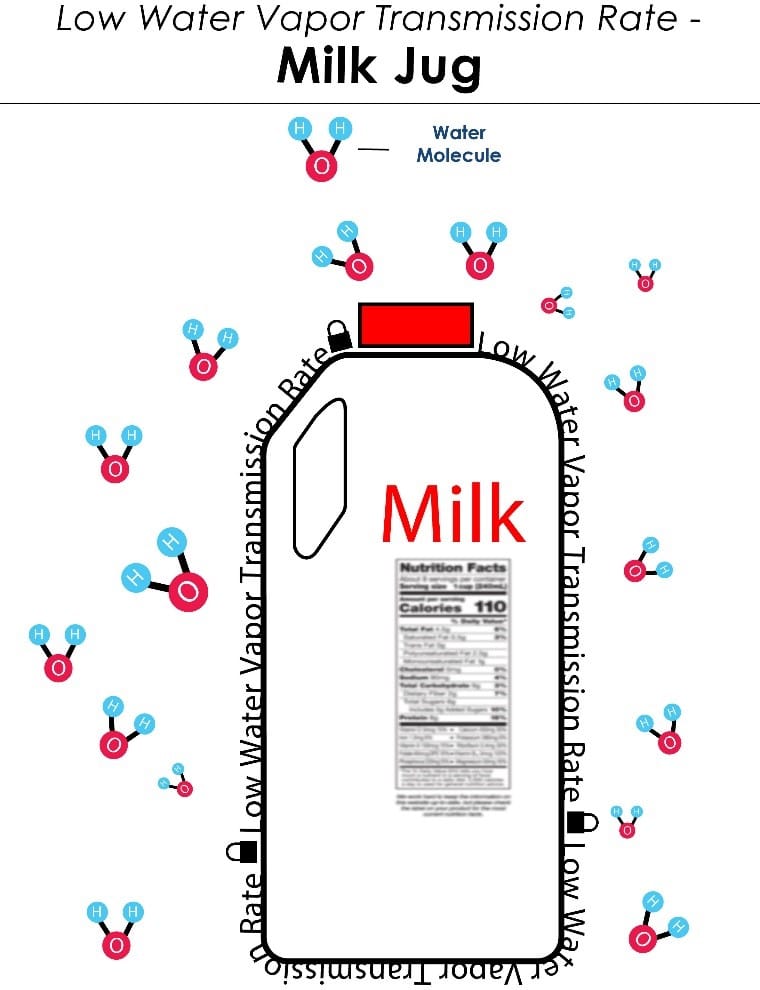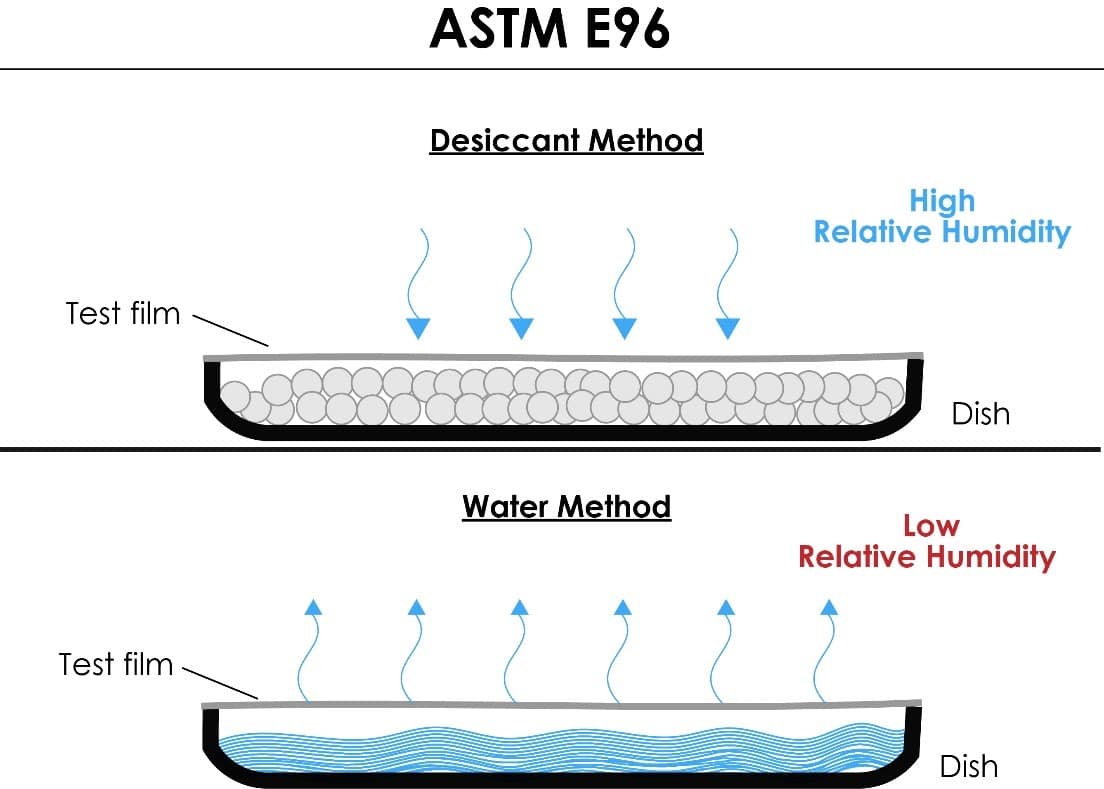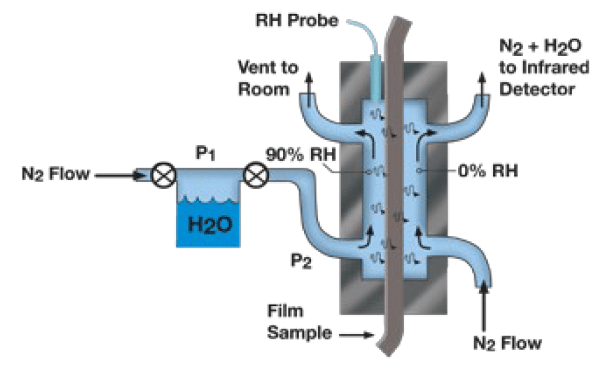What is water vapor transmission rate?
Water vapor transmission rate (WVTR), or moisture vapor transmission rate (MVTR), is the rate at which water molecules permeate through a barrier substance.
Where is Water Vapor Transmission used?
The water vapor transmission process is continuously taking place around us. And in industries such as food, pharmaceutical, and packaging, WVTR is extremely important and must be determined and measured before products reach the end market. Depending on the nature of the product, sometimes a high WVTR is needed, and in other cases a low WVTR is necessary.
Example: Low Water Transmission Rate
An easy example to cement the concept is a milk jug in your refrigerator. Milk jugs are typically made of high-density polyethylene, which has a low water vapor transmission rate. This is good – you don’t want water molecules entering and spoiling your milk! In most all food and pharmaceutical packaging, having a low water vapor transmission rate is considered good because it prevents spoilage.

Example: High Water Vapor Transmission Rate
When a product has a high WVTR, it means that the moisture permeates through the barrier material quickly. A prime example of this is in performance or athletic clothing. The fabrics normally used in this type of clothing have high water vapor transmission rates. This makes the clothing more comfortable, lightweight, and breathable – a good thing if you’re sweating!
What determines water vapor transmission rate?
Many factors determine water vapor transmission rates. The main elements being:
Time
The time element is relative to the purpose of the product. How much time it takes the water vapor to travel from one side of the packaging to the other side. The test is reported in 24-hour or 1-day terms. Depending on the requirements of the package, the transmission rate may be very low or very high. For example, food and pharmaceutical packaging may require no transmission, or accept a very low water vapor transmission rate, while high-performance clothing for athletes, or material used for corrosion control covers, require a high water vapor transmission rate to function properly.
Area
How large or small is the area where the water will permeate? Again, this depends mostly on the nature of the product. For smaller items, area may be measured per square inch, for larger products, per square yard, etc.
Temperature/Humidity
Elevated temperatures cause higher water vapor transmission rates. This is because water molecules move faster at higher temperatures. The relative humidity on the outside of the barrier substance also plays a role. The higher the relative humidity of the environment, the lower the water vapor transmission rate will be. Equilibrium on either side of the barrier plays a key role.
Thickness
All other factors being equal, thicker materials will have a low water vapor transmission rate because the water takes longer to permeate through. Thinner materials will have a higher rate because the water has less distance to travel.
How is water vapor transmission rate measured?
The two common and standardized methods for measuring WVTR are ASTM E96, and ASTM F1249. ASTM (American Society for Testing Materials) is an international standards organization that develops standards for industries ranging from healthcare to construction.
ASTM E96
This standard is composed of two different procedures for measuring WVTR: the desiccant method and the water method. With both methods, a dish is filled with either water or desiccant and placed in a humidity and temperature-controlled chamber. Using the desiccant method, a dish is filled with desiccant and the test barrier or film is sealed to the top of the dish and the dish is placed in an environment with high relative humidity. After the pre-determined testing time has passed, the dish is weighed to measure the amount of moisture that has passed through the test barrier and been absorbed by the desiccant. Using the water method, a dish is filled with water, sealed with the test-substance, placed in an environment with low relative humidity and then weighed to measure the amount of water vapor that has escaped from the dish in the given time.

The F1249 method is widely considered to be the more modern and accurate method for testing WVTR. The F1249 method utilizes the technology of MOCON Inc’s PERMATRAN-W which is a machine that integrates a patented pressure-modulated infrared (PMIR) sensor that can accurately detect water vapors down to one part per million of water vapor (mocon.com). The PERMATRAN-W models typically consist of two chambers – one dry chamber with flowing Nitrogen, and one chamber with controlled temperature and humidity settings. The test-film is placed between the two chambers and the water vapor that escapes through the film into the Nitrogen chamber is carried to the infrared sensor which then measures the amount of moisture and calculates the WVTR.

How Transhield uses Water Vapor Transmission Rate
From our 5mil, 7mil, 10mil, XT, and Armordillo® fabric’s, which all have their own mid-to-high level WVTR’s, to TopCure – our Concrete Curing Cover which has a very low WVTR, Transhield materials are engineered to achieve a certain water vapor transmission rate. And undergo WVTR testing using the ASTM F1249 method with the MOCON Permatron.
Learn more about Transhield’s Advance Protective Cover Technology and the applied applications for use.